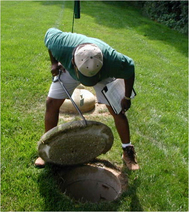|
As mentioned in previous editions, the 2012 MPCA SSTS Annual Report is now available online. One of the important pieces of information contained in the report is the number of replacement systems installed each year. This is an important statistic because existing noncompliant systems represent a potential threat to groundwater and/or human health. Because information about upgraded systems is considered so important, the Legislature is now requiring local programs to report this information as a condition of receiving grant money for local SSTS programs (see article below).
The statistics on new and replacement systems reportedly installed in 2012, and over the past 11 years, are shown in Figure 13 of the annual report.
 Local units of governments reported that 3,778 new
systems and 5,245 replacements were installed in 2012. About 58 percent
of the construction permits (5,245) were reported as replacements
systems. Replacement systems included both residential systems
(year-round and seasonal) and systems used by other establishments (i.e.
restaurants and resorts).
Replacement systems
represent existing sewage disposal systems that are replaced through
various local triggers, such as point of sale, land use permits,
building permits, conditional use permits, variances, and complaints.
The replaced systems could include old systems (i.e. 55 gallon barrels,
cesspools), straight pipes, ITPHS, and systems without adequate vertical
separation to groundwater (seasonally saturated soils) and shallow
bedrock.
The volume of wastewater generated at
these 5,245 systems is significant, estimated at over 358 million
gallons per year (assuming 2.5 person/permit, 75 gal/person, 365
days/year).
Over
a period of 11 years, the number of reported replacement systems was
67,606 systems; this represents an estimated flow of 4.62 billion
gallons per year now treated with a modern septic system. Flow was
conservatively estimated as follows: 67,606 systems x 2.5 people per
residence x 75 gal per day x 365 days per year.
Counties, cities,
townships, and special purpose units of government, are collectively
playing a significant role in assuring noncompliant systems are upgraded
or replaced. Local units of governments should be recognized for their
importance in local wastewater treatment improvement efforts.
 In a continuing effort to assist county SSTS programs, the MPCA works with the Legislature to secure funding to support and enhance the work counties do to promote effective sewage treatment. Last session, the Legislature provided funds for county base grants of $18,600/year and add-on grants for counties that have adopted additional ‘triggers’ to promote SSTS compliance.
With the add-on grants, the following counties’ SSTS administrative grants are now at $20,000 for calendar year 2013: Aitkin, Becker, Brown, Carlton, Cass, Chisago, Clearwater, Crow Wing, Dodge, Douglas, Faribault, Lincoln, Mille Lacs, Morrison, Mower, Murray, Pine, Pipestone, Rice, Scott, St. Louis, Stearns, Todd, Traverse, Wadena, Washington, and Wright. Of these, all but five qualified based on the fact that their ordinance includes a provision requiring inspection of the SSTS at the time of property transfer.
Other triggers that qualified a county for an add-on grant were conducting an SSTS compliance inventory or requiring an inspection when any permit is requested by a homeowner. There will be additional funding available in 2014 for the add-on competitive grants.
|
|